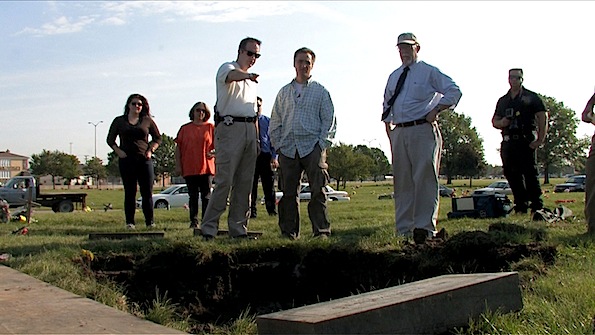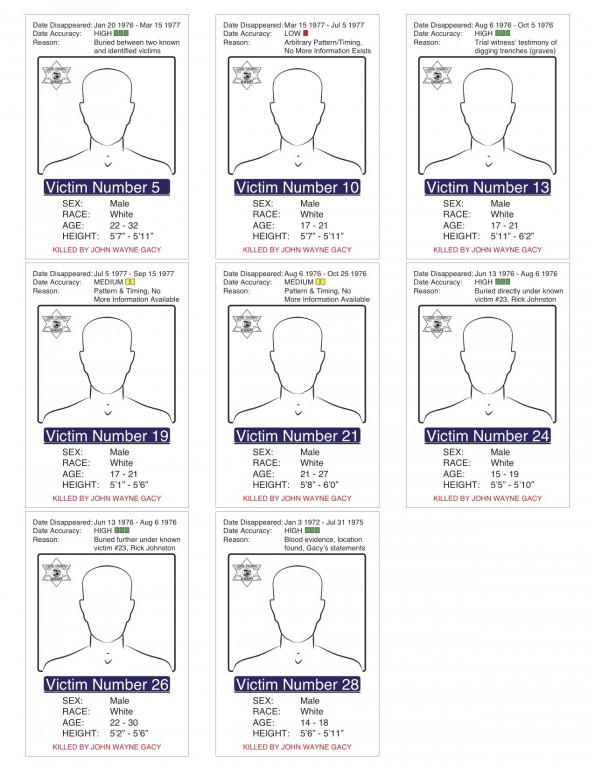More than 30 years after a collection of skeletal remains was found beneath John Wayne Gacy’s house, detectives have secretly exhumed bones of eight young men who were never identified in hopes of answering a final question: Who were they?
RENEWED EFFORT AIMS TO IDENTIFY GACY’S UNKNOWN VICTIMS
Sheriff Dart approves exhumations, DNA tests in an effort to find matches
More than 30 years after 33 young men were murdered by serial killer John Wayne Gacy, detectives are relying on advancements in DNA technology in a new effort to identify eight victims who have never been identified, Cook County Sheriff Thomas J. Dart announced on Wednesday.
The eight unidentified victims of Gacy represent the single largest cold case investigation in Cook County Sheriff’s Office history.
In an outreach effort that could stretch across the nation, Sheriff Dart has established a telephone hotline and online link that will allow for the collection of information from those who suspect they may be related to one of those eight unknown victims. Information can be obtained at www.cookcountysheriff.com or by calling 800-942-1950.

Sheriff Dart oversees exhumation in an effort to ID John Wayne Gacy victims. (Cook County Sheriff Photo — more photos on Facebook.com/ArlingtonHeightsCrime John Wayne Gacy Victim ID Effort album)
In December 1978, Cook County Sheriff’s Police detectives, along with Des Plaines Police detectives, investigated a horrific crime scene under and around Gacy’s home in unincorporated Norwood Park. It was there – and in the Des Plaines River – that Gacy dumped 33 young men he lured into his home between 1972 and 1978, with promises of construction jobs, drugs and alcohol, by posing as a police officer or offering money for sex.
His identified victims disappeared between 1972 and 1978 and were white males between the ages of 14 and 21. They were from Chicago and other parts of the Midwest.
At that time, investigators only had the use of dental records, x-rays, missing persons reports and Gacy’s own confessions to identify victims. Though 25 victims have been identified, eight have continued to remain unidentified. Their race, gender, approximate height, approximate age and approximate time of disappearance are all that is known about them.
At the time, items investigators believed could be associated with unknown victims were displayed to the public. In addition, some basic facial approximation efforts were done, but were not considered to be reliable enough to help make an identification. No identifications resulted.
In early 2011, Sheriff Dart put a renewed focus on clearing dozens of the department’s cold case investigations, when discussions began about the department’s largest cold case. Pointing to improvements in investigative techniques since 1978 – including DNA technology – Dart approved exhumations of all eight unknown Gacy victims, in order to obtain enough DNA to provide a profile that could be used to make comparisons to others.
Because the Illinois State Police crime lab does not do investigative DNA work involving bones, detectives contacted the renowned University of North Texas Center for Human Identification for assistance in identifying the recovered remains of Gacy’s unknown victims.
Cook County Sheriff’s detectives learned that the mandible and maxilla of Gacy’s unknown victims had been removed from the bodies prior to their interments at area cemeteries and stored at the Cook County Medical Examiner’s Office. But when they tried retrieving those jaw bones to gather DNA, they learned that the Medical Examiner had buried the bones with other unknown and indigent people in Homewood Memorial Gardens in 2009.
On June 1, investigators attempted to locate those remains and after three digs with backhoes, they found the remains in a coffin, buried below another casket filled with infants, animal remains and other bagged medical tissue. The eight jaw bones were found to be bagged and in individual containers, remaining in good condition. A sheriff’s detective then personally delivered the bones to the Fort Worth laboratory.
In August, sheriff’s investigators were notified that nuclear DNA traits from a mother and father which allow for easier identification – had only been secured for four of the eight unidentified victims and that additional bone material would need to be obtained in order to make other matches. In September, exhumations of the other four unidentified victims were conducted at Resurrection, Maryhill, Queen of Heaven and Woodlawn Memorial cemeteries. Select bone material was removed and again personally delivered to UNT laboratory officials.
DNA profiles have now been secured from all eight victims. Now, investigators hope to begin taking buccal swabs from potential family members and matching it to DNA secured from the victims’ remains. Sheriff’s administrative staff will handle phone and email inquiries about submitting a DNA sample and arrangements will be made to safely secure swabs. Submitted results will be processed by UNT lab staff before they are returned in late 2011 or early 2012.
Sheriff Dart thanked Dr. Art Eisenberg and his staff at the University of North Texas Center for Human Identification, Dr. Anne Grauer, interim chairman of the Department of Anthropology at Loyola University of Chicago, and Dr. Edward Pavlik, a renowned forensic odontologist and orthodontist who helped identify Gacy’s victims in 1978, Woodlawn Cemetery and Catholic Cemeteries of Chicago for their assistance in this initiative. He also thanked retired Sheriff’s Police Detectives Frank Braun, Phil Bettiker and Greg Bedoe, along with Cook County Judge William Kunkle and sheriff’s compliance officer Robert Egan, who helped investigate and prosecute Gacy, respectively, and who have provided unparalleled insights and assistance to current sheriff’s police detectives as they have carried out this work.
2011 TIMELINE
Early 2011 – Sheriff Dart begins a new focus on the office’s cold cases. The office’s largest cold case investigation involves Gacy’s 8 unknown victims.
April – Citing advancements in DNA work and other investigative techniques, Sheriff Dart authorizes detectives to begin researching old files and interviewing those originally involved in the Gacy case in an effort to help identify those 8 unknown victims. Investigators learn the jaw bones were buried. They also reach out to the University of North Texas laboratory about conducting the DNA work necessary to establish identities.
June – Exhumations begin to find the casket containing the eight jaw bones. After three digs with a backhoe, investigators find the casket, buried under another casket filled with infants, animal remains and other bagged medical tissue. The 8 jaw bones are in good condition and are flown to the UNT laboratory.
August – UNT lab directors notify investigators that DNA profiles have been secured for only 4 of the 8 unidentified victims. Though mitochondrial DNA has been secured from all, nuclear DNA has been secured from only 4. They will need additional bone material to secure full DNA profiles on those 4.
September – Exhumations of those 4 are conducted at Resurrection, Maryhill, Queen of Heaven and Woodlawn Memorial cemeteries. Femur bones are removed and delivered to UNT laboratory officials
October –DNA profiles are secured on six of the unknown victims, with the remaining two expected by months’ end.
October – Sheriff Dart invites those who believe they are related to a Gacy victim to submit a DNA sample. Either one immediate family member or multiple secondary relatives are needed.
JOHN WAYNE GACY TIMELINE
1970 – Released from Iowa prison on sodomy conviction
1971 – Purchases home at 8213 W. Summerdale in unincorporated Norwood Park
1972 – Gacy murders his first victim, Timothy McCoy of Michigan, after picking him up at a bus terminal in Chicago. Gacy buries McCoy in concrete in the crawl space under his home.
1975-1978 – Gacy murders 32 more young men
1978 – Des Plaines police, investigating the disappearance of 15-year-old Robert Piest from a local pharmacy, search Gacy’s home and ultimately charge him with murder
1978 – The Cook County Sheriff’s Office takes control of the crime scene at Gacy’s home. Over the next 8 years, 29 bodies are ultimately found under and around his home. Four others are found in the Des Plaines River, where Gacy began dumping bodies after running out of space at his home.
1979 – Of 33 victims, only 25 are positively identified. At the time, dental records are primary tool used for identification. Jaw bones of 8 unidentified victims are separated from the bodies and preserved in containers, stored with the Cook County Medical Examiner’s Office. The rest of the remains of those 8 are buried in area cemeteries.
1980 – Gacy stands trial and is convicted of 33 counts of murder.
1994 – Executed at Stateville Correctional Center.
2009 – Unknown to investigators, the Cook County Medical Examiner removes the 8 jaw bones from the morgue and buries them, along with other unknown and unknown indigent people, in an unmarked grave in a hill at Homewood Memorial Gardens.
TERMS
Mandible: Lower jaw and Maxilla: Upper jaw
The mandible and maxilla of Gacy’s eight unidentified victims were removed from the bodies and kept in separate containers to help with any attempts at later identification.
Nuclear DNA: DNA traits are inherited from a mother and father
Analzying DNA from the mandible and maxilla bones, lab workers secured nuclear DNA profiles on four victims
Mitochondrial DNA: DNA traits inherited only from the mother
Analyzing DNA from the mandible and maxilla bones, lab workers were initially able to secure mitochondrial DNA profiles on four victims
Femur: thigh bone
For the four victims with mitochondrial DNA profiles, investigators exhumed those remains from area cemeteries, removed the femur bone and had the lab obtain DNA from those bones.
CODIS: Combined DNA Index System
Funded by the FBI, this is a federally recognized repository for all DNA profiles entered into systems by law enforcement. Six nuclear DNA profiles and two mitochondrial DNA profiles have been entered into CODIS with no matches.
Buccal swab: Pronounced “buckle,” an investigative technique using a cotton swab to collect DNA from cells inside a person’s cheek. Results from these tests are usually returned within three months.
University of North Texas Center for Human Identification: A project of the National Institute of Justice, it has assisted in the identification of almost 600 missing persons cases, including 95 “cold” hits and 491 “warm” hits from Hawaii to New York, over the last 10 years. It is one of eight DNA labs in the U.S. which routinely uploads genetic information into the CODIS missing person database.

